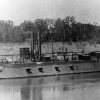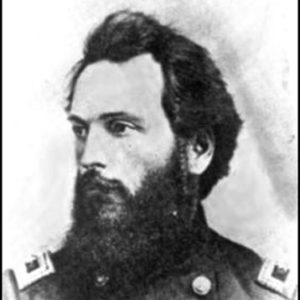calsfoundation@cals.org
Charles Edward Hovey (1827–1897)
Charles Edward Hovey was a major general in the Union army during the Civil War, serving as the Federal commander at the Action at Hill’s Plantation (a.k.a. Battle of Cotton Plant) and leading a brigade at the capture of Fort Hindman. While he served only briefly in Arkansas, Hovey was involved in these two major actions, which helped ultimately to secure the state for the Union.
Born in Thetford, Vermont, on April 26, 1827, Hovey was the son of Alfred Hovey and Abigail Howard Hovey. One of eleven children, Hovey attended school until the age of fifteen, when he was hired as a teacher. After several years in the education field, Hovey worked as a lumberman before entering Dartmouth College in 1848. Teaching while he attended classes, Hovey graduated in 1852. He taught in Framingham, Massachusetts, for two years and married Harriette Farnham Spofford in 1854 before moving to Peoria, Illinois. Leading the school at Peoria, he also served as the president of the State Teachers Association and editor of Illinois Teacher. In June 1857, Hovey became the first principal of Illinois State Normal University, which is now Illinois State University.
At the outbreak of war in 1861, Hovey traveled to Washington DC to confer with Abraham Lincoln about the possibility of a commission. Lincoln had previously served as the attorney for the Illinois Board of Education, on which Hovey served. While in Washington, Hovey witnessed the Battle of First Manassas (Bull Run) and was reported to have joined in the fighting. Returning to Illinois, he organized and was commissioned colonel of the Thirty-third Illinois Infantry. Many of the men of the regiment were either students, graduates of the university, or schoolteachers.
Moving to Missouri in September 1861, the regiment was stationed near Pilot Knob through the winter and early part of 1862. That summer, the regiment moved southward to join Major General Samuel Ryan Curtis’s army, which was marching eastward across Arkansas. Hovey led Federal forces to victory on July 7 at Cotton Plant (Woodruff County). After several weeks at Helena (Phillips County), Hovey and his men were sent to Old Town Landing, where they loaded confiscated cotton onto steamers for shipment north. During this period, Hovey was appointed as a brigadier general, but the U.S. Senate never acted on the appointment, which expired in March 1863.
After a furlough in Illinois, Hovey rejoined his unit in time to participate in the capture of Fort Hindman. Now a commander, Hovey commanded a brigade in Brigadier General Frederick Steele’s division of Major General William Tecumseh Sherman’s corps. Under the overall command of Major General John A. McClernand, the Federals attacked the fort while supported by a fleet of gunboats. Hovey was wounded in both arms during the Battle of Arkansas Post but continued to lead his brigade.
Hovey was upset that he had been passed over for promotion, and, suffering from both his arm injuries and recurring bouts of malaria, he resigned his commission in May 1863. Rather than returning to Illinois, he traveled to Washington, where was eventually joined by his wife and son, Alfred. Another son, Richard, was born the next year. Hovey studied law in the capital and, at the end of the war, received a brevet promotion to major general of volunteers in recognition of his service at Fort Hindman.
After attending the fortieth anniversary celebration at Illinois State University in 1897, Hovey spent several months in Illinois before he was strong enough to return home to Washington. He died on November 17, 1897, in Washington and is buried at Arlington National Cemetery. Hovey’s younger son, Richard, would become a well-known poet.
For additional information:
Burke, Eric Michael. “Facing the Enemy: The Crucible of Combat Forged Unique Unit Cultures within Civil War Regiments.” Civil War Times 58 (June 2019): 30–39.
Charles E. Hovey Presidential Papers. Dr. JoAnn Rayfield Archives. Milner Library. Illinois State University, Normal, Illinois.
Marshall, Helen. “Charles E. Hovey: Educator and Soldier.” Journal of the Illinois State Historical Society 50 (Autumn 1957): 243–276.
Warner, Ezra. Generals in Blue. Baton Rouge: Louisiana State University Press, 1964.
David Sesser
Henderson State University
 Military
Military Steamboats (Civil War)
Steamboats (Civil War) Charles Hovey
Charles Hovey 




Comments
No comments on this entry yet.